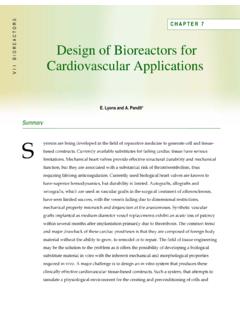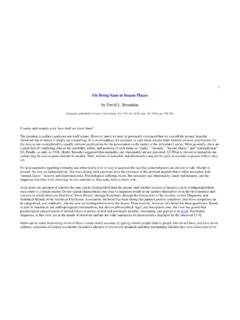Transcription of Adipose Tissue and Adipocyte Differentiation: …
1 S. Niemel *, S. Miettinen, Sarkanen and N. Ashammakhi Summary H uman Adipose Tissue represents an abundant, practical and appealing source of donor Tissue for autologous cell replacement. Recent results have shown that stem cells within the stromal-vascular fraction of Adipose Tissue display a multilineage developmental potential. Adipose Tissue -derived stem cells can be differentiated towards adipogenic, osteogenic, chondrogenic, myogenic and neurogenic lineages. To take full advantage of this new technology, it will be necessary to understand Adipose Tissue -specific signalling cascades and genes regulating Adipose Tissue -derived stem cell differentiation to various mesenchymal lineages. Adipocyte differentiation is an ordered multistep process requiring the sequential activation of several groups of transcription factors, including CCAAT/enhancer-binding protein (C/EBP) gene family and peroxisome proliferator-activated receptor- (PPAR- ).
2 Hormones and growth factors that affect Adipocyte differentiation , such as insulin and insulin-like growth factor, transfer external growth and differentiation signals to differentiating adipocytes. In addition, extracellular matrix proteins are also important in regulating the differentiation process. Several preadipocyte and stem cell culture models have been developed to improve the quality of Tissue -engineered fat by culture-expanded adipocytes. Recent advances in bioengineering and cell biology of Adipose Tissue have led to new therapeutic potentials for regenerative medicine. KEYWORDS: Adipocyte , Tissue engineering, Adipose Tissue , regeneration Adipose Tissue and Adipocyte differentiation : Molecular and Cellular Aspects and Tissue Engineering Applications C H A P T E R 4 Topics in Tissue Engineering, Vol. 4. Eds. N Ashammakhi, R Reis, & F Chiellini 2008. *Correspondence to: Sanna-Mari Niemel (E-mail Niemel et al.)
3 Adipose Tissue 2 Topics in Tissue Engineering, Vol. 4. Eds. N Ashammakhi, R Reis, & F Chiellini 2008. Introduction Fat Tissue engineering offers great potential in repealing limitations realized with classical approaches in reconstructive surgery. The clinical applications for Tissue engineered fat are vast and variable, including reconstructive, cosmetic and corrective indications. Adipose Tissue represents an ideal source of autologous cells for Tissue engineering strategies because of its unique accessibility and expendability. Adipose Tissue is particularly easily obtained in large amounts using the techniques of liposuction. Fat Tissue contains numerous different cell types that may be advantageous to Tissue engineering applications and regenerative medicine.
4 In recent years, Adipose Tissue -derived stem cells have been cultured and differentiated into several lineages, such as fat, bone, cartilage, muscle and neuronal cells. Promising results indicate that these stem cells have therapeutic potential and utility for future Tissue engineering applications and cell-based therapies. Adipocyte differentiation is characterized by sequential changes in the expression of specific genes that determine the specific Adipocyte phenotype of the cells. This is reflected by the appearance of various early, intermediate and late mRNA/protein markers and triglyceride accumulation. The regulation of Adipocyte genes occurs primarily at the transcriptional level. Several transcription factors that play a central role in the control of adipogenesis have been identified. Among these are CCAAT/enhancer binding protein (C/EBP) gene family and peroxisome proliferator-activated receptor (PPAR- ) that coordinate the expression of genes that create and maintain the Adipocyte phenotype.
5 During Adipocyte differentiation , remarkable changes occur also in cell morphology, cytoskeletal components and the level and type of extracellular matrix (ECM) components secreted. A thorough understanding of Adipose Tissue on a cellular and molecular level and mimicking the events of natural development is essential for regeneration of additional and self-regenerating Adipose Tissue for reconstructive or cosmetic purposes. Adipose Tissue structure and function Adipose Tissue is the most prevalent Tissue in the human body. It is commonly found in subcutaneous loose connective Tissue , and it also surrounds internal organs. Mature adipocytes constitute the majority of cells in Adipose Tissue . Besides mature adipocytes, fat Tissue contains several other cell types, including stromal-vascular cells (SVC) such as fibroblasts, smooth muscle cells, pericytes, endothelial cells, and adipogenic progenitor cells Niemel et al.
6 Adipose Tissue 3 Topics in Tissue Engineering, Vol. 4. Eds. N Ashammakhi, R Reis, & F Chiellini 2008. or Recent research shows that Adipose Tissue plays a more dynamic role than previously recognized in physiological processes of the whole body. Adipose Tissue is divided into two subtypes, white and brown fat. White fat is widely distributed and it represents the primary site of fat metabolism and storage, whereas brown fat is relatively scarce and its main role is to provide body heat, which is essential for newborn babies. White Adipose Tissue is the major energy reserve and its primary function is to store triacylglycerol (TG) in periods of energy excess and to release energy in the form of free fatty acids during energy , 141 Fat Tissue also plays an important role in numerous processes through its secretory products and endocrine functions.
7 Adipocytes secrete various factors known to play a role in immunological responses, vascular diseases and appetite regulation. Leptine is a peptide hormone primarily made and secreted by mature adipocytes, and it has various biological activities, including effects on appetite, food intake and body weight regulation, fertility, reproduction and ,83 Adipose Tissue is an important site for oestrogen biosynthesis and steroid hormone ,87,114 In addition, Adipose Tissue secretes a variety of peptides, cytokines and complement factors, which act in an autocrine and paracrine manner to regulate Adipocyte metabolism and growth, as well as endocrine signals to regulate energy ,83 Although Adipose Tissue is vitally important to various normal processes of the human body, it has also many implications for human disease states. Obesity is a common health problem in industrialized countries and is considered a major risk factor for noninsulin-dependent diabetes mellitus,105 cardiovascular diseases and Obesity has also been associated to other pathological disorders, including some types of cancer, such as breast, ovarian, renal and colon ,31,74,162 The adipogenic lineage and in vitro models of Adipocyte differentiation Several studies on multipotent clonal cell lines suggest that the Adipocyte lineage is derived from an embryonic stem cell precursor with the capacity to differentiate into the mesodermal cell types of adipocytes, chondrocytes, osteoblasts, and ,89 Adipoblasts, which are the earliest unipotential cells believed to belong to the adipogenic lineage and are thought to be derived from mesodermal stem cells.
8 Can commit to the adipogenic lineage and become preadipocytes. In a suitable micromilieu, preadipocytes can differentiate into mature, lipid-synthesizing and lipid-storing The growth of white Adipose Tissue is a result of both increased Adipocyte size as well as an increase in Adipocyte number. The potential to Niemel et al. Adipose Tissue 4 Topics in Tissue Engineering, Vol. 4. Eds. N Ashammakhi, R Reis, & F Chiellini 2008. produce new fat cells from fat cell precursors continues throughout the ,130,131 While molecular pathways that are important in later stages of Adipocyte differentiation have been identified, the early molecular events that promote commitment of mesenchymal precursor cells to the adipogenic lineage are not well Almost all work on adipogenesis has used either predetermined clonal cell lines or primary cultures of Adipose Tissue -derived stromal-vascular precursor cells, which have been successfully cultured from a number of species including ,48,57,116 Cultures derived from primary tissues contain cells at different stages of development and can not be as scientifically controlled as preadipose cell lines, but they probably reflect more accurately the normal condition in In addition.
9 Primary cells can be isolated from various species and from different fat depots, as well as from animals of different physiological states and ages, allowing comparisons between cells of different origins. During growth, cells of preadipose cell lines as well as primary cultures of Adipose -derived precursor cells morphologically resemble fibroblasts. At confluence, induction of differentiation by appropriate treatment leads to conversion of the cells to a spherical shape accumulating lipid droplets and acquiring the morphological and biochemical characteristics of the mature white Adipocyte (Fig. 1). Various differentiation protocols have been developed for preadipose cell lines and primary cultures of Adipose -derived precursor cells, and the responsiveness of preadipocytes from various sources to inducing agents may vary In the presence of fetal calf serum, spontaneous differentiation of preadipocytes into fat cell clusters occurs to some degree.
10 The amount of lipid synthesis can be controlled, in a dose-dependent manner, by varying the amount of serum in growth media. differentiation can be enhanced by the inducing agents such as dexamethasone, which is used to stimulate the glucocorticoid receptor pathway, and 3-isobutyl-1-methylxantine (IBMX) (or 1-methyl-3-isobutylxanthine, MIX), which is used to stimulate the cAMP-dependent protein kinase pathway. High concentrations of insulin have also been used in combination with these inducing ,140 The involvement of insulin/insulin-like growth factor 1 (IGF-1), glucocorticoid and cAMP signalling pathways in the Adipocyte differentiation process has been ,117 Niemel et al. Adipose Tissue 5 Topics in Tissue Engineering, Vol. 4. Eds.











